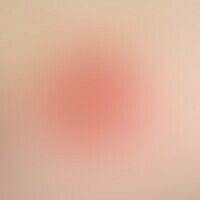Image diagnoses for "Torso"
551 results with 2173 images
Results forTorso

Vitiligo (overview) L80

Lymphomatoid granulomatosis C83.8
Lymphomatoid granulomatosis: uncharacteristic, painless, reddish-brown plaque S. Casuistry

Lupus erythematosus systemic M32.9
Systemic lupus erythematosus: acute maculopapular exanthema, accompanied by recurrent fever attacks, fatigue and tiredness, arthralgia, inflammation parameters +, ANA high titer positive, rheumatoid factor +, DNA-AK+.

Nevus anaemicus Q82.5
naevus anaemicus in periperous neurofibromatosis. coin-sized to palm-sized, almost jagged, white spot (here marked by arrows). this bizarre spot is visible with varying degrees of clarity. it is particularly noticeable when the surrounding area is reddened as a "negative contrast". after intensive rubbing of the spot, no reddening is visible in the area of the spot. .

Erythema multiforme, minus-type L51.0
erythema multiforme: suddenly appeared, for 2 days existing, itchy, flat, cocard-like plaque on the back of a 17-year-old woman. the skin change appeared shortly after the beginning of antibiotic therapy for urinary tract infection. further, similar skin changes appeared on other parts of the body.

Mycosis fungoides C84.0
Mycosis fungoides: 52-year-old man (tumour stage of mycosis fungoides). 52-year-old man (tumour stage of mycosis fungoides). Multiple, disseminated, 1.0-5.0 cm large, itchy and slightly painful, clearly consistency increased, red, rough, partially scaly plaques and nodules appear in universally reddened skin. Clinically and histologically detectable LK infestation.

Acne conglobata L70.1
Acne conglobata: confluent and melting acne pustules, here aggregated to an atrophic red scar.

Microsphere B35.0
Microspore. detailed picture with anular plaque, marginal scaling ruffle with central pallor (trunk).

Xanthome eruptive E78.2
Xanthomas, eruptive:disseminated, 0.1-0.3 cm large, yellow-brown, flat raised, superficially smooth and shiny, firm papules in dense seeding in a 54-year-old patient with known hyperlipoproteinemia type IV.

Transitory acantholytic dermatosis L11.1
Transitory acantholytic dermatosis (M.Grover): detailed picture

Parapsoriasis en plaques large L41.4
Parapsoriasis en plaques, grandiose: completely symptomless, sharply defined, disseminated spots and plaques; only when the skin is folded does a cigarette-paper-like pseudoatrophic architecture of the skin surface become visible (important diagnostic sign!).

Mastocytosis (overview) Q82.2
Mastocytosis. type: Multiple mastocytomas Multiple, chronically stationary, approx. 0.6 x 0.7 cm large, localized on the entire integument, disseminated, round to oval, brown, smooth, little itchy spots and plaques in a 4-year-old boy.

Pemphigus vulgaris L10.0
Pemphigus vulgaris: multiple, chronic, since 3 years intermittent, symmetric, trunk-accentuated, easily injured, flaccid, 0.2-3.0 cm large, red spots, plaques and pallor, confluent to, weeping and crusty areas; extensive infestation of the oral mucosa and capillitium.

Tinea corporis B35.4
Tinea corporis in immunodeficiency. Marginal area of the lesion with broad, raised, scaly margins. Centrally located healing pattern with scaly plaques and papules between normalized skin areas.

Circumscribed scleroderma L94.0
unilateral circumscribed scleroderma: unilateral "segmental" circumscribed scleroderma. the lightly pigmented large-area plaques have existed for about 5 years. no increasing "growth" in the last few months.

Contact dermatitis allergic L23.0
Acute contact allergic eczema with scattering reaction after application of a gel containing diclofenac; linear patterns (Koebner phenomenon) in the upper third of the dermatitis.

Tinea corporis B35.4
Tinea corporis in immunodeficiency. 24 x 18 cm large, chronic (>12 months), anular, not pre-treated, itchy plaque (inlet: marginal zone enlarged) with delicate Collerette-like marginal scaling.







